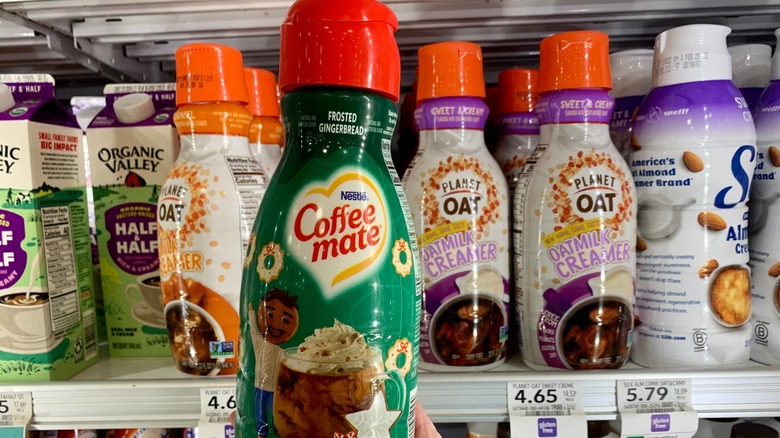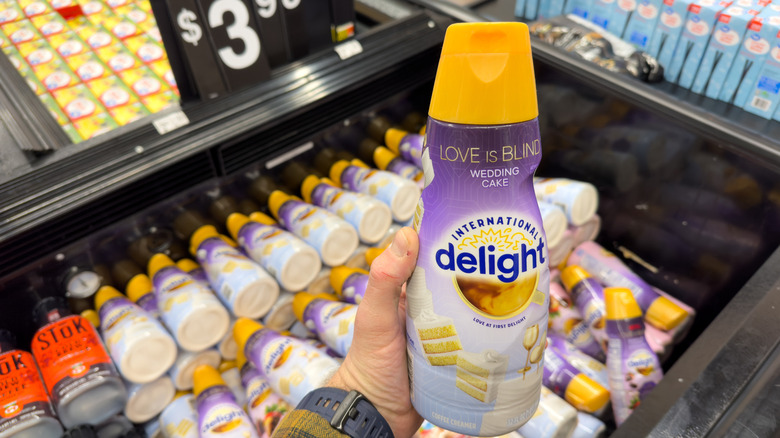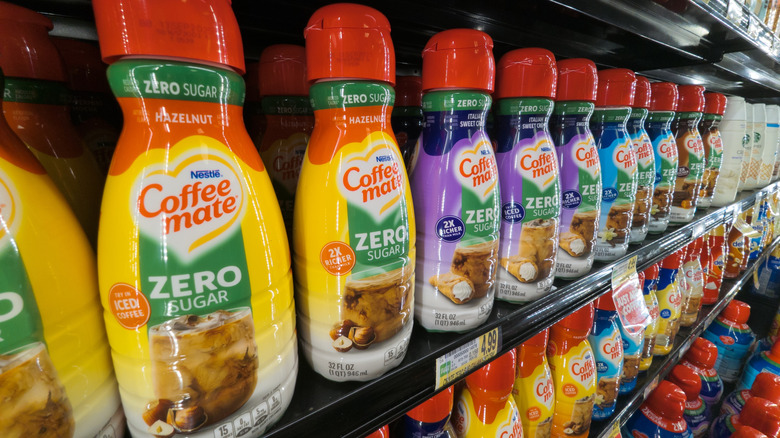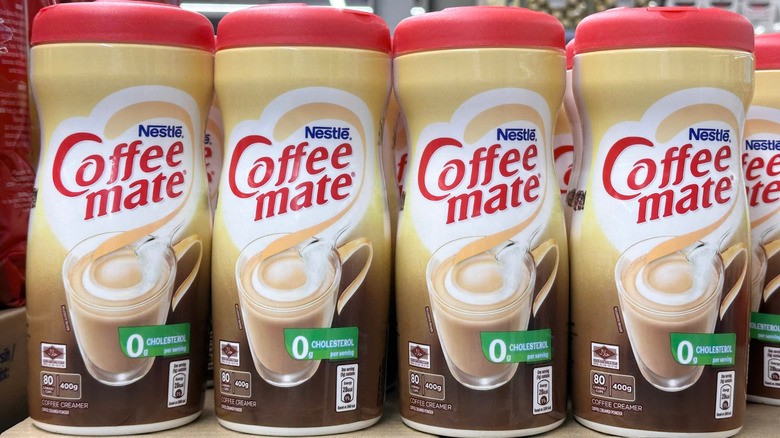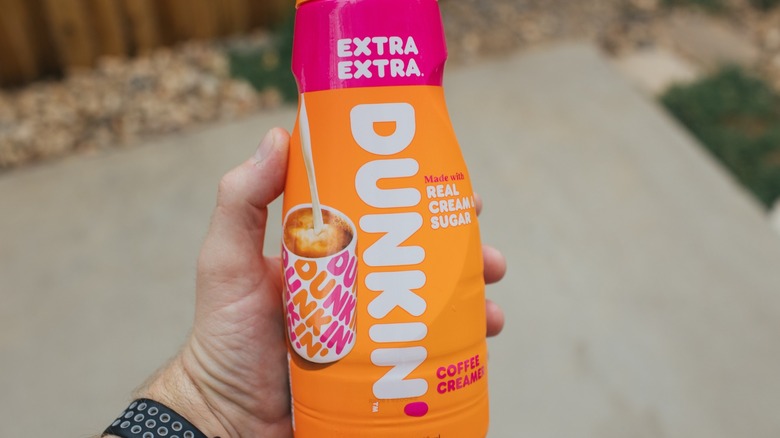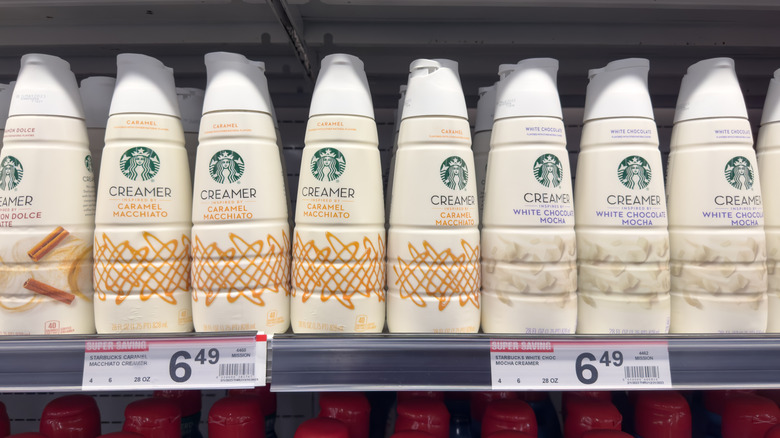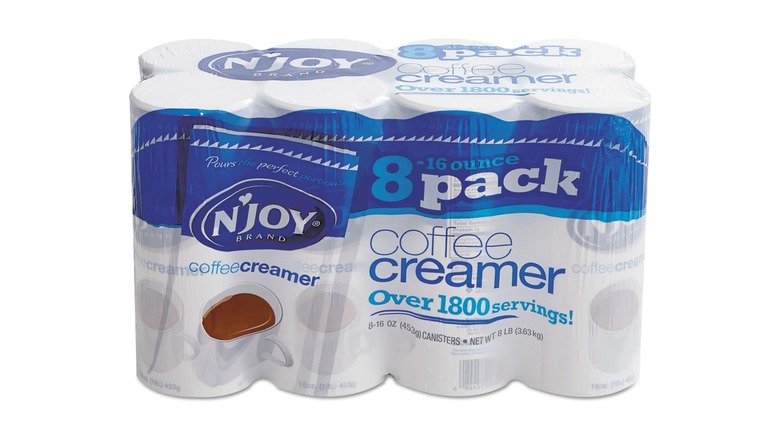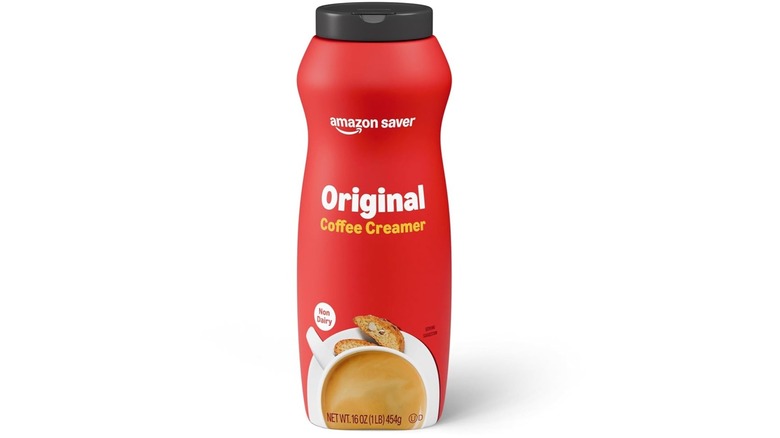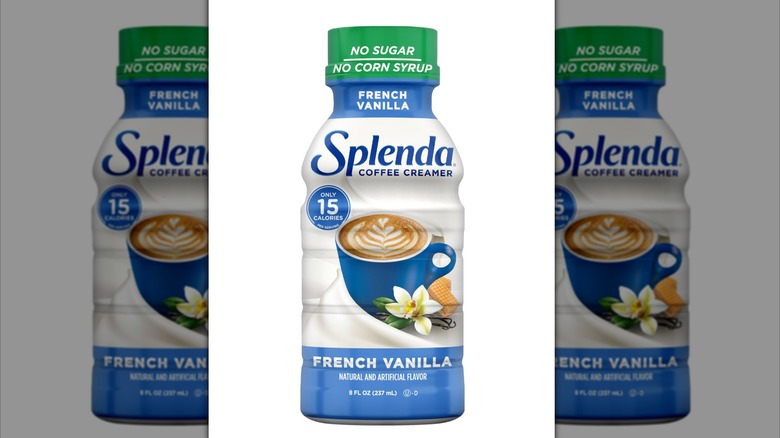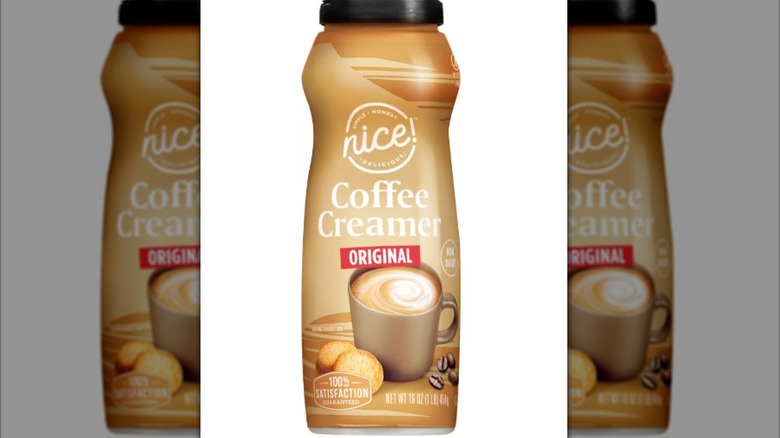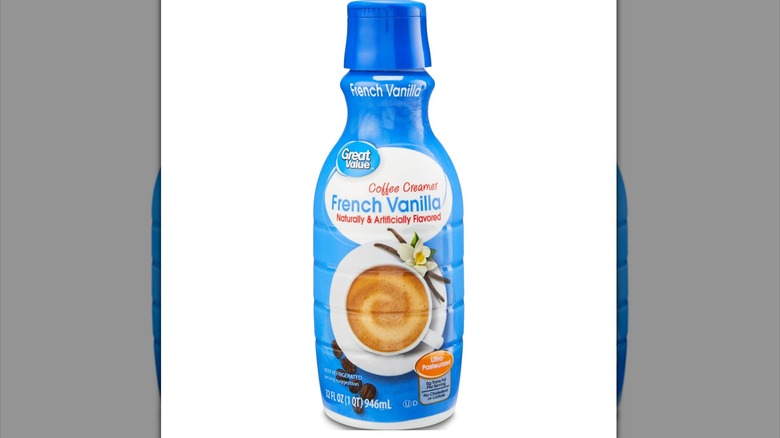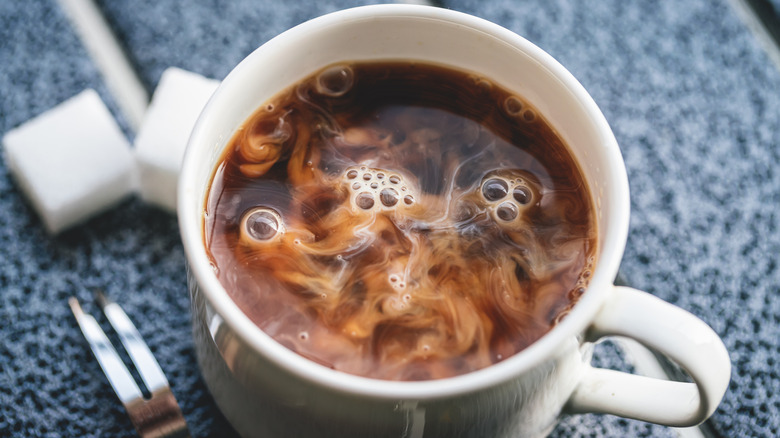10 Coffee Creamers Made With The Lowest-Quality Ingredients
We may receive a commission on purchases made from links.
You already know coffee creamer is about as far from a natural food product as possible. From the formulated flavors to the ultra-white colors to the inclusion of artificial sweeteners, the quality of coffee creamer ingredients is in question as soon as you pour it into your cup. But brands like natural bliss and Chobani are capable of offering more wholesome coffee creamers made from nothing more than skim milk, cream, sugar, and a bit of flavoring. In contrast to these healthier creamers, many of the bigger names on the coffee creamer circuit make regular practice of using low-quality ingredients to create coffee creamers that may taste amazing but don't exactly present consumers with peak nutrition.
Which producers feature coffee creamers with the lowest-quality ingredients on the market? I pulled out a magnifying glass to read the fine print on the labels of all of the best known coffee creamers in the refrigerator case and came up with a list of brands that seem to showcase less than ideal additives to make coffee creamers palatable. By dropping in chemical elements that aren't necessarily required to achieve a workable product, these coffee creamers with low-quality ingredients are worth giving a second look if premium products are preferred as part of your coffee-drinking practices. Formulas may vary by flavor, and while everything on the ingredient list is considered food safe, not all of it may measure up to your standard of mindful consumption.
International Delight
One of the most familiar coffee creamers on the market, International Delight also happens to contain a slate of less than ideal ingredients that make sweetening your java a dicey endeavor. If a leader in the industry features some questionable stuff in its recipe, it's easy to assume that the product can't be made without them; after all, why would you incorporate unnecessary substances if you could choose to keep them out? Aspects like preventing the liquid from separating too much and ensuring a creamy experience when the creamer hits the coffee likely necessitate a little tinkering. But even if the strange business International Delight puts into its products is safe to consume, it's still good to know what you're taking in so you can limit your exposure if you choose to.
What might you want to limit your exposure to in this popular collection? Palm oil is a prime culprit, one of those less-beneficial oils that may also be damaging the environment but that keeps the creamer luscious until you can enjoy it with your Sumatran blend. There's also dipotassium phosphate to keep the separation to a minimum, carrageenan to ensure thickness, mono- and diglycerides to stabilize the substances in the bottle, and sodium stearoyl lactylate, yet another thickener. Yes, the variety of International Delight flavors is fantastic. But a good rule of thumb is if you need Google Translate to help you pronounce the ingredients, they're not the best you can buy.
Coffee Mate Liquid
Coffee Mate is the other most-present coffee creamer in the dairy section, showing off a selection of flavors and blends that fan out like peacock feathers. It seems like a new concoction shows up every few months, either as a special promotion or a holiday edition or a twist on the concept of coffee creamer, like cold foam or soda mix-ins. If only the formulation of this sweetener were as thoughtful as its clever variants. Alas, coming up with a continuous flow of refrigerated creamer means mixing in some substances that don't sound particularly grand.
As a contender for the crown in the Coffee Mate versus International Delight coffee creamer competition, there are some overlapping similarities between these heavyweights' dubious ingredients. In addition to dipotassium phosphate to keep things together and mono- and diglycerides to keep things stable, Coffee Mate also stirs in cellulose gel, cellulose gum, and carrageenan to keep things thick and creamy. A concoction like this begs the question: Just how thick and creamy does a coffee creamer need to be, and can you eliminate some of these additives and still have a perfectly viable product worth enjoying? Corporate food science is hard.
Coffee Mate Powder
Shifting the Coffee Mate creamer recipe into the realm of shelf-stable powdered creamers might make it possible to lighten your coffee without the need of a fridge, but that doesn't make it any higher quality when it comes to the ingredients used. You can find this desk-friendly version in the aisle with the coffee beans and grounds, though whether you choose to include it in your caffeine ritual may be subject to knowing what you're actually swirling around in your mug.
It starts with corn syrup solids, a standard for powdered creamer, and moves on to hydrogenated vegetable oil, which may be coconut, palm kernel, soybean, or a combination of some or all of them. Do you really want to roll the dice on the type of solidified oil your digestive tract is forced to break down? Probably not. Then there are the familiar dipotassium phosphate and mono- and diglycerides, with a little salt for whatever it adds to the moment. There's also annatto for coloring, which is a plant-based ingredient, but why does powdered creamer need additional coloring? There are too many speed bumps on this fast lane to creamed coffee. You should probably steer clear of this Coffee Mate creamer in the lineup.
Dunkin'
Once Dunkin' had footing in the home coffee market, it wasn't long before Dunkin' creamers arrived on the scene. These pink and orange bottles challenged the better-known brands by bringing in familiar flavors with a bit of a donut shop twist. Suddenly, you could replicate you favorite Dunkin' coffee creations in your own kitchen and give them your own budding barista spin. If only the ingredients the company used were a little less questionable, this new product line from one of America's favorite fast food chains could have been a slam dunk — or a slam Dunkin', as the case may be.
Peruse the label on the back of the bottle and you'll find some familiar verbiage in the low-quality ingredients category. Palm oil makes an appearance, as do dipotassium phosphate, and carrageenan, the dynamic duo of thickening and separation prevention. And though the potassium citrate in the recipe is also a known medication for helping reduce kidney stone occurrences, it isn't a likely reason for the substance showing up in Dunkin' creamer. Instead, it acts as a stabilizer and helps balance the acidity in the liquid. It may also be included as a preservative, which can help your opened creamer last longer ... though with low-quality ingredients like these, that may not be such a good thing.
Starbucks
Starbucks creamer makes it unnecessary to hit the drive-thru on your way into work, especially with deluxe editions like Lavender Vanilla and Peppermint Mocha that replicate the chain's upscale flavor combinations. Though it's true that you never quite know what's going into your cup when the barista starts pouring, you can read the label on the back of the creamer bottle to see what Starbucks has in store for you when you go DIY with your drip of the day. And while asking for cream or milk while you're in a coffee shop might get you something relatively pure, a splash of this store-bought selection includes a few elements you may not be counting on.
The siren of Seattle gives coffee lovers a creamer with a few kinks when it comes to high-quality ingredients. Starbucks takes the dairy route with its base, which is a nice change. But one of the not-so-sweet inclusions is vegetable oil, high oleic soybean oil in particular, which is considered a healthier option than other plant-based oils due to its low saturated fat and high monounsaturated fat content. But knowing it's in a drinkable form here — one that may not get measured out in a specified serving as the label recommends — puts it squarely in the questionable category. You'll also find gellan gum joining the coffee creamer klatch, another form of thickener included to make your coffee moments luxe. It also takes Starbucks creamer one step further from a basic formulation.
N'Joy Powder
You may be unaware of the presence of N'Joy powdered coffee creamer, but you've undoubtedly encountered it at some of the lesser quality coffee counters, maybe at an inexpensive hotel, or in the lobby of your car repair shop. It's the basic blue canister that sits next to the sugar and the pot of java to provide at least something that lightens your coffee, even if it's not flavored like anything but cream. Coming up with a blend of ingredients that don't need cold storage means a lot of food science goes into the mix. In the world of questionable coffee creamer ingredients, that means a mashup of stuff you may not want to be ingesting on the regular.
To be fair, everything on the label is food-safe; it just isn't the purest version of coffee creamer you could hope for, powdered or otherwise. N'Joy uses a recipe that includes corn syrup solids and palm or palm kernel oil, two of the most emphatic "no" ingredients in the world of processed foods. There's also dipotassium phosphate, silicon dioxide, datem (which is more commonly found as a conditioner that softens bread dough). Toss in a few mono- and diglycerides, artificial color and you have a scoop of sad substances to make your coffee lighter and sweeter, yes, but also a lot less trustworthy.
Amazon Saver Powder
Formerly the Happy Belly label (which was formerly known as Amazon Fresh), the newly-redubbed Amazon Saver line includes a powdered coffee creamer that has just about as many unsavory ingredients as you'd expect from a product that can last at room temperature yet still turn your cup of Colombian into a smoother, sweeter beverage at a moment's notice. The company goes out of its way to provide a more cost-effective creamer, but it comes at the expensive of a set of elements more suitable for the coffee lover who appreciates a better-quality creamer.
For your Amazon bucks and your same-day delivery service, you'll get a canister full of corn syrup solids, hydrogenated coconut and/or palm kernel oil, dipotassium phosphate, and mono- and diglycerides. You'll also have some sodium caseinate, which makes the ordinarily non-dairy creamer kind of dairy based, plus silicon dioxide to keep the contents from clumping. It may not be too detrimental to your health if you enjoy it once in a while. But if you drink coffee creamer every day and you happen to go with Amazon Saver powder, you run the risk of sneaking low-quality ingredients into a practice that's supposed to make you feel better about your choices, not worse.
Splenda Sugar Free
Rather than just watching its alternative sweetener be featured in sugar-free versions of other coffee creamers, Splenda offers its own version of a sugar-free coffee creamer that may sound like a card watcher's sweet dream come true, but really poses some confusion when it comes to what the liquid under the lid actually contains. It turns out you can't just take cream, remove the lactose, and replace it with your lab-created chemical sweetener ... and Splenda has chosen a different direction with its branded creamer.
Splenda introduces a few artificial sweeteners into its creation, no surprise considering the nature of the company. But having erythritol in addition to sucralose and acesulfame-K feels like overkill, especially when this tricky chemical has been linked to the potential formation of blood clots. If you can find a more favorable creamer to use and avoid putting this, plus thickeners like cellulose gel and gum in your body, you'll have much more peace of mind when it comes to sipping on your double lattes. Avoiding sugar may be a noble cause in the battle for better health, but not when it's been replaced with a bunch of undesirable gunk.
nice! Powder
The prospect of having something to make a coffee a little less bitter might sound nice, but nice! brand coffee creamer from drug store giant Walgreens is on the list of creamers with ingredients that call for a side-eye. It's another powdered creamer that has to walk the line between lasting without being in the fridge and providing the sort of dissolvable quality users of powdered creamer anticipate. Unfortunately, it seems like this type of java adjuster requires a specific configuration of dry ingredients that commonly show up in the canister, no matter which brand you happen to be using.
Like the other powdered creamers on the shelf, nice! brings you creamed coffee courtesy of hydrogenated vegetable oil that could be palm, palm kernel, coconut, or soybean; the label doesn't make the distinction to let you know which it is. There are also corn syrup solids, dipotassium phosphate, and mono- and diglycerides hanging out, the four horsemen of the cream-pocalypse. And if that isn't enough to shift your purchasing power to a more mindful product, maybe the anti-caking silicon dioxide in the recipe will do the trick. The name may say it's nice, but these squishy ingredients beg to differ.
Great Value
Walmart gives the coffee creamer sector a lower-priced version of the big guys' forms and flavors with its Great Value liquid creamers which are highly comparable in flavor and consistency to what you would pay potentially twice as much for from the better known national brands. While it might seem that the basic composition is almost a carbon copy of those more familiar producers' products, there are a few additional ingredients tossed in that take the concoction in a more factory food direction than you might want in a coffee creamer.
Great Value goes great guns with a few different undesirable ingredients in its secret formula. Here, you get dipotassium phosphate and mono- diglycerides, with carrageenan, polysorbate 60, and sodium stearoyl lactylate as thickeners, plus a little "color added" to make things mysterious. If you're a thoughtful consumer, the last thing you want in an already-suspect array of ingredients is some vaguely described dye to perfect the color of your creamer. You're better off with plain-old milk and sugar.
How I chose these creamers
To gauge which ingredients would be considered lesser quality in a coffee creamer, I started with one of the most natural versions of coffee creamer on the market: natural bliss, a line created by Coffee Mate that contrasts the more highly chemicalized version of the company's products with bottles featuring nothing but cream or skim milk, sugar, and flavoring. This pure version of coffee creamer provided a map that told me anything more than this would be considered excess, and anything that sounded like it came from a laboratory couldn't be thought of as particularly high quality. That helped me narrow the field to additives that either alter the flavor, the consistency, or the shelf life of the creamer.
Considering that most brands of creamer incorporate at least one or two ingredients that aren't of the utmost quality into products, it wasn't difficult to research the ingredients list to find out which items to feature on the list. Anything that qualified as a thickener or a stabilizer to keep the liquid from separating was considered low quality, as well as corn syrup solids, hydrogenated oils, and added colors. Since there's really no tracking the choices for natural and artificial flavors used in these creamers, I chose to not call them out, though there's obviously a huge difference between using real vanilla and so-called natural vanilla flavor, something to consider as well when evaluating the ingredient quality in a creamer.
